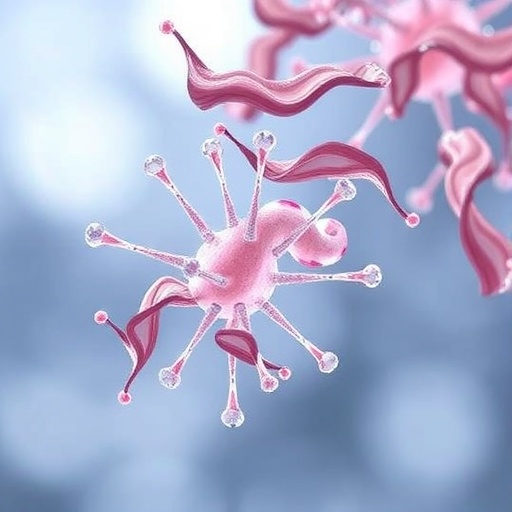In a groundbreaking study published recently in Cell Death Discovery, researchers have unveiled an unexpected biological mechanism that may lie at the heart of olfactory dysfunction—the gradual loss or impairment of the sense of smell. This seminal work focuses on the fibrillogenesis, or amyloid fibril formation, of odorant-binding proteins (OBPs), a class of proteins critical for the transport and recognition of odor molecules in the nasal cavity. The discovery sheds light on previously unknown pathways of protein aggregation occurring in the olfactory system, potentially linking these molecular events to widely reported smell disorders observed in aging individuals and patients suffering from neurodegenerative diseases.
Odorant-binding proteins, abundant in the olfactory mucus, serve as essential molecular shuttles that capture volatile odorants from the air and deliver them to olfactory receptors on sensory neurons. This selective binding process underpins the exquisite sensitivity and specificity of the olfactory system. However, Stepanenko and colleagues have now found that OBPs are not invulnerable. Their normally stable beta-barrel structure—critical for maintaining proper function—can undergo subtle structural destabilizations triggered by physiologically mild stressors. These perturbations initiate the self-assembly of OBPs into amyloid fibrils, pathological aggregates typically associated with neurodegeneration and other protein-misfolding diseases.
The researchers highlight the significance of the olfactory mucus as a complex biochemical milieu that strongly influences the fate of OBPs. This mucus is a crowded microenvironment laden with mucoglycoproteins, immunoglobulins, cytokines, various enzymes, and salts. Such molecular crowding, a well-documented accelerator of amyloid formation in other protein systems, can increase local OBP concentration to supersaturation levels. Elevated concentration in a confined space enhances protein-protein interactions, promoting the nucleation and elongation of fibrillar aggregates. These findings suggest that natural conditions within the nasal mucus inherently favor fibrillogenic reactions once OBPs become destabilized.
.adsslot_gZ4RTsvLDp{ width:728px !important; height:90px !important; }
@media (max-width:1199px) { .adsslot_gZ4RTsvLDp{ width:468px !important; height:60px !important; } }
@media (max-width:767px) { .adsslot_gZ4RTsvLDp{ width:320px !important; height:50px !important; } }
ADVERTISEMENT
Beyond molecular crowding, the study details how physiological or pathological changes, such as reduced nasal secretion volume and increased mucus viscosity, further drive OBP aggregation. Such alterations commonly result from dehydration or chronic inflammation of the upper respiratory tract, conditions unfortunately widespread across populations. When the mucus thickens or diminishes in volume, OBPs accumulate at higher local concentrations. This concentration effect, combined with altered mucus rheology, not only hampers odorant transport but may also facilitate the ordered aggregation of OBPs. The disruption of their normal trafficking roles could exacerbate olfactory sensory neuron dysfunction, thereby linking molecular aggregation directly to the symptomology of impaired smell.
Mechanical forces in the nasal cavity are additional contributors to protein destabilization and aggregation. The continuous ciliary movements within the mucus layer generate shear forces and can induce cavitation—the formation and collapse of microscopic air bubbles. These physical stresses may subtly perturb the native conformation of OBPs, nudging them toward pathogenic self-assembly pathways. While the exact role of these effects in vivo remains to be fully elucidated, the research underscores the multifactorial nature of fibrillogenesis initiation, where mechanical, chemical, and environmental factors intertwine.
Another crucial aspect unveiled by the authors concerns the role of biochemical changes in the nasal environment that may amplify fibrillogenesis. Experimental evidence indicates that OBPs form amyloid fibrils more readily in vitro under conditions of decreased acidity and elevated temperature. These alterations mimic inflammatory states and infections, such as rhinosinusitis, known to affect nasal mucus properties during illness. This highlights the potential for inflammatory diseases to accelerate pathological OBP aggregation, inviting new perspectives on how localized inflammation may indirectly precipitate sensory deficits through molecular misfolding processes.
Strikingly, the researchers raise an intriguing possibility that pharmaceutical agents commonly delivered nasally could unintentionally destabilize OBPs. For instance, certain nasal sprays—containing anti-inflammatory, antibacterial, or mucolytic compounds—may disrupt OBPs’ native disulfide bonds. A well-known example is acetylcysteine, a powerful reducing agent frequently used in mucolytic formulations, which can reduce these bonds and thus compromise the protein’s structural integrity. This finding signals a need for caution and further investigation into nasal pharmacotherapies, particularly with regard to their long-term impact on olfactory protein homeostasis and sensory outcomes.
A fascinating dimension of this study lies in its exploration of cross-seeding effects, where amyloid fibrils of one protein can trigger fibrillogenesis in another. OBPs’ propensity to form fibrils may be induced by amyloid seeds derived from other pathological proteins implicated in neurodegenerative disorders such as Alzheimer’s, Parkinson’s, and Huntington’s diseases. This potential cross-talk between distinct amyloid species could illuminate part of the molecular basis for the olfactory dysfunction frequently observed as an early symptom in these diseases. It is increasingly evident that such cross-seeding mechanisms contribute to overlapping clinical manifestations by promoting heterologous protein aggregation.
Cross-amyloid interactions have been demonstrated extensively in other systems, including the co-aggregation of beta-amyloid with alpha-synuclein and interactions with tau or islet amyloid polypeptide. These insights support the hypothesis that olfactory dysfunction might not be a mere bystander symptom but rather a reflection of systemic amyloid pathology potentially spreading along the nasal-brain axis. Compounding this notion, some studies suggest that amyloid aggregates may circulate between peripheral tissues and the brain, establishing a bidirectional pathogenic communication channel. This raises the possibility that the olfactory system serves as an early gateway or reservoir for neurodegenerative protein aggregates.
The dual origin of potential cross-seed triggers—the study notes—is worthy of attention. Both endogenous amyloid species accumulating within the body and exogenous sources from the environment may initiate or accelerate OBP fibrillogenesis. The environmental dimension remains largely unexplored but opens avenues for investigating how factors such as airborne amyloidogenic particles or infection-derived protein fragments might influence nasal protein homeostasis. This perspective injects a new environmental health consideration into the conversation about amyloid diseases and sensory dysfunctions.
Notably, although in vitro experiments have modeled many aspects of OBP fibrillogenesis under controlled conditions, comprehensive in vivo studies are conspicuously absent. The authors emphasize that in vivo scenarios present a more complex and dynamic landscape, where multiple stressors and physiological variables converge. Future research must tackle these challenges to establish causal relationships between OBP aggregation and clinical olfactory impairment. This will require sophisticated imaging, biochemical analysis, and animal models to validate the pathophysiological relevance of these pioneering findings.
This research opens a promising new frontier in understanding olfactory dysfunction, particularly its molecular underpinnings related to protein misfolding and aggregation. By highlighting OBPs as amyloidogenic entities susceptible to physiological and pathological perturbations, the study redefines how clinicians and researchers conceptualize loss of smell in both common and disease contexts. It thus provides a valuable framework both for diagnostic exploration and for the eventual development of targeted therapeutic interventions aimed at preserving OBP function and preventing fibril formation.
While the immediate implications resonate strongly with neuroscience and sensory biology, the broader significance encompasses fields ranging from protein chemistry to pharmaceutical sciences and toxicology. The intersection of mechanical stresses, biochemical modifications, pharmacological impacts, and neurodegenerative cross-seeding events underscores the intricate network of factors shaping protein homeostasis in sensory systems. This complexity demands interdisciplinary approaches and careful translational strategies to mitigate the emerging risks associated with OBP fibrillogenesis.
In summary, Stepanenko et al.’s research marks a transformative step toward decoding the enigmatic causes of olfactory dysfunction. It challenges prevailing notions by positing OBP aggregation as a central molecular event in sensory decline. The convergence of in vitro experimentation and epidemiological observations heralds a new era in olfactory science, where detailed mechanistic insights drive innovative diagnostic and therapeutic pathways. As the global burden of neurodegenerative and inflammatory diseases rises, such molecular revelations hold immense promise for enhancing patient outcomes and understanding the sensory dimensions of complex disorders.
Subject of Research: Odorant-binding protein (OBP) fibrillogenesis and its role in olfactory dysfunction.
Article Title: An unexpected insight into the cause of olfactory dysfunction: fibrillogenesis of odorant-binding proteins.
Article References:
Stepanenko, O.V., Sulatsky, M.I., Sulatskaya, A.I. et al. An unexpected insight into the cause of olfactory dysfunction: fibrillogenesis of odorant-binding proteins. Cell Death Discov. 11, 370 (2025). https://doi.org/10.1038/s41420-025-02671-x
Image Credits: AI Generated
DOI: https://doi.org/10.1038/s41420-025-02671-x
Tags: amyloid fibril formationimplications for smell disordersmolecular pathways of smell disordersneurodegenerative disease connectionsodorant-binding proteinsolfactory dysfunction mechanismsolfactory receptor sensitivityphysiological stressors affecting olfactionprotein aggregation in the olfactory systemresearch in olfactory biologysmell loss in agingstructural destabilization of proteins





